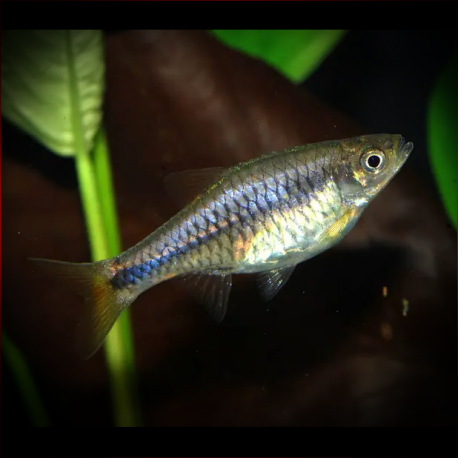More info
Datasheet
| Minimum Tank Size | 40 litres / 10.57 US gallons |
| Maximum Size | 3.1cm / 1.22inches |
| Temperature | 22.2°C / 71.96°F - 25.6°C / 78.08°F |
| Hardness | 1-12ºdH |
| pH | 4.0-7.5 |
General Description
The Rasbora Lacrimula, commonly known as the Red Cherry Rasbora, is a species characterized by possessing small tubercules on the dorsal surface and caudal fin, with a color pattern featuring a dark midlateral stripe and a teardrop-shaped blotch at the caudal peduncle. It is a peaceful species that thrives in a community tank environment and is ideally kept in schools of at least 8-10 individuals. This species is a micropredator in nature, feeding on small insects, worms, and crustaceans.
Aquarium Setup
The Red Cherry Rasbora thrives in a well-planted aquarium with a dark substrate and the addition of floating plants to create a natural environment. Filtration should be gentle, and water conditions should be maintained with a hardness of 1-12 dH, a pH of 4.0-7.5, and a temperature of 22.2-25.6°C. It is essential to provide hiding spots and maintain a clean tank free of organic pollutants.
Behaviour
This species is a schooling fish by nature and should be kept in groups to reduce stress and enhance their natural behavior. In a group setting, males compete with each other to display their best colors and attract female attention. The Red Cherry Rasbora is compatible with a variety of fish species, making it a versatile choice for community tanks.
Feeding and Diet
In the wild, the Red Cherry Rasbora feeds on small insects, worms, and zooplankton. In captivity, they accept dried foods but should also be offered a varied diet of live and frozen foods such as Daphnia and Artemia to enhance coloration and stimulate breeding behavior. Regular feeding of small live and frozen fare is recommended for optimal health.
Reproduction & Dimorphism
The Red Cherry Rasbora is an egg-scattering, continuous spawner with no parental care. To encourage breeding, a separate breeding tank with dim lighting and a mesh substrate for egg protection is recommended. Adult males are slimmer, smaller, and more vibrant in coloration compared to females. Males compete for female attention during breeding.
Habitat and Distribution
This species is native to the Ulu Belayan drainage in Kalimantan Timur, Indonesian Borneo. Found in slow-flowing streams with sand, clay, and mud substrates, this species prefers slightly acidic to neutral water conditions. The habitat of the Red Cherry Rasbora includes small streams within oil palm plantations with clear water, where it feeds on a diet of small aquatic organisms.

